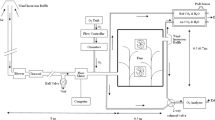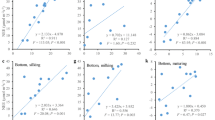Abstract
The relationship between leaf photosynthetic capacity (p n, max), net canopy CO2- and H2O-exchange rate (NCER and E t, respectively) and canopy dry-matter production was examined in Lollium perenne L. cv. Vigor in ambient (363±30 μl· l-1) and elevated (631±43 μl·l-1) CO2 concentrations. An open system for continuous and simultaneous regulation of atmospheric CO2 concentration and NCER and E t measurement was designed and used over an entire growth cycle to calculate a carbon and a water balance. While NCERmax of full-grown canopies was 49% higher at elevated CO2 level, stimulation of p n, max was only 46% (in spite of a 50% rise in one-sided stomatal resistance for water-vapour diffusion), clearly indicating the effect of a higher leaf-area index under high CO2 (approx. 10% in one growing period examined). A larger amount of CO2-deficient leaves resulted in higher canopy dark-respiration rates and higher canopy light compensation points. The structural component of the high-CO2 effect was therefore a disadvantage at low irradiance, but a far greater benefit at high irradiance. Higher canopy darkrespiration rates under elevated CO2 level and low irradiance during the growing period are the primary causes for the increase in dry-matter production (19%) being much lower than expected merely based on the NCERmax difference. While total water use was the same under high and low CO2 levels, water-use efficiency increased 25% on the canopy level and 87% on a leaf basis. In the course of canopy development, allocation towards the root system became greater, while stimulation of shoot dry-matter accumulation was inversely affected. Over an entire growing season the root/shoot production ratio was 22% higher under high CO2 concentration.
Similar content being viewed by others
Abbreviations
- C350:
-
ambient CO2, 363±30 μl·l-1
- C600:
-
high CO2, 631±43 μl·l-1
- c a :
-
atmospheric CO2 level
- c i :
-
CO2 concentration in the intracellular spaces of the leaf
- Et :
-
canopy evapotranspiration
- I o :
-
canopy light compensation point
- NCER:
-
canopy CO2-exchange rate
- p n :
-
leaf photosynthetic rate
- PPFD:
-
photosynthetic photon flux density
- r a :
-
leaf boundary-layer resistance
- RD:
-
canopy dark-respiration rate
- r s :
-
stomatal resistance
- WUE:
-
water use efficiency
References
Boote, K.J., Jones, J.W. (1986) Equations to define canopy photosynthesis from quantum efficiency, maximum leaf rate, light extinction, leaf area index and photon flux density. Proc. 7th Congr. on Photosynthesis, Providence, Rhode Island), Biggins, J., ed. Martinus Nijhoff, Dordrecht, The Netherlands
Brown, K., Higginbotham, K.O. (1986) Effect of carbon dioxide enrichment and nitrogen supply on growth of boreal tree seedlings. Tree Physiol. 2, 223–232
Ceulemans, R., Kockelbergh, F., Impens, I. (1986) A fast, low cost and low power requiring device for improving closed loop CO2 measuring systems. J. Exp. Bot. 37, 1234–1244
De Wit, C.T. (1978) Stimulation of assimilation, respiration and transpiration of crops. Centre for Agricultural Publishing and Documentation, Wageningen
Drake, B.G., Read, M. (1981) Carbon dioxide asimilation, photosynthetic efficiency and respiration of Chesapeake Bay salt march. J. Ecol. 69, 405–423
Drake, B.G., Rogers, H.H., Allen, L.H. (1985) Methods of exposing plants to elevated carbon dioxide. In: Direct effects of increasing carbon dioxide on vegetation (Rep. DOE/ ER-239, Dept. of Energy, Washington D.C.), pp. 11–35, Strain, B.R., Cure, J.D., eds. NTIS, Springfield, Va., USA
Farquhar, D.G., Sharkey, T.D. (1982) Stomatal conductance and photosynthesis. Annu. Rev. Plant Physiol. 33, 317–345
Gates, D.M. (1980) Biophysical ecology. Springer, New York Heidelberg Berlin
Grantz, D.A., Moore, P.H., Zeiger, E. (1987) Stomatal responses to light and humidity in sugarcane: prediction of daily time courses and identification of potential selection criteria. Plant Cell Environ. 10, 197–204
Louwerse, W. (1980) Effects of CO2 concentration and irradiance on the stomatal behaviour of maize, barley and sunflower plants in the field. Plant Cell Environ. 3, 391–398
Nijs, I., Impens, I., Behaeghe, T.J. (1988) Effects of rising atmospheric carbon dioxide on gas exchange and growth of perennial ryegrass. Photosynthetica 22, 44–50
Nobel, P.S. (1983) Biophysical plant physiology and ecology. Freeman, San Francisco
Norby, R.J., Pastor, K., Melillo, J.M. (1986) Carbon-nitrogen interactions in CO2-enriched white oak: physiological and long-term perspectives. Tree Physiol. 2, 243–259
Sestak, Z., Catsky, J., Jarvis, P.G. (1971) Plant photosynthetic production: manual of methods. Junk, The Hague
Author information
Authors and Affiliations
Rights and permissions
About this article
Cite this article
Nijs, I., Impens, I. & Behaeghe, T. Leaf and canopy responses of Lolium perenne to long-term elevated atmospheric carbon-dioxide concentration. Planta 177, 312–320 (1989). https://doi.org/10.1007/BF00403588
Received:
Accepted:
Issue Date:
DOI: https://doi.org/10.1007/BF00403588




